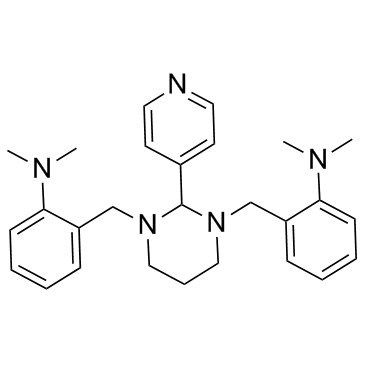| Description |
GANT 61 is an inhibitor of Gli1 and Gli2 targeting the Hedgehog/GLI pathway.
|
| Related Catalog |
|
| Target |
Gli1/2[1]
|
| In Vitro |
GANT61 (20 μM) induces greater cell death than targeting Smo (cyclopamine). GANT61 (0, 5, 10, 20 μM) inhibits clonogenic survival of human colon carcinoma cell lines. GANT61 (20 μM, 0-72 hr) down-regulates Gli1 and Gli2 expression in HT29 cells. GANT61 (0, 10 μM or 20 μM) differentially regulates genes involved in the balance between cell death and cell survival[1]. GANT-61 inhibits cell viability and induces apoptosis in pancreatic CSCs. GANT-61 inhibits expression of downstream targets of Shh pathway, decreases Gli-DNA interaction, Gli transcriptional activity and Gli nuclear translocation in pancreatic CSCs. GANT-61 differentially regulates genes involved in cell survival, cell death and pluripotency. GANT-61 inhibits motility, invasion and migration of CSCs[2]. GANT61 sensitivity positively correlates to GLI1 and negatively to MYCN expression in the neuroblastoma cell lines tested. GANT61 downregulates GLI1, c-MYC, MYCN and Cyclin D1 expression and induces apoptosis of neuroblastoma cells[3].
|
| In Vivo |
GANT-61 (40 mg/kg, i.p., three days per week) inhibits CSC tumor growth in NOD/SCID IL2Rγ null mice[2]. GANT61 (50 mg/kg, p.o.) enhances the effects of chemotherapeutic drugs used in the treatment of neuroblastoma in an additive or synergistic manner and reduces the growth of established neuroblastoma xenografts in nude mice[3].
|
| Cell Assay |
Cells (1.5×104) are incubated with 0, 1, 5 and 10 μM of GANT-61 in 250 μL of culture medium in 96-well plate for 48 and 72 h. Cell viability is determined by the XTT assay. In brief, a freshly prepared XTT-PMS labeling mixture (50 μL) is added to the cell culture. The absorbance is measured at 450 nm with λ correction at 650 nm. The cell viability is expressed as ΔOD (OD450 − OD650). The apoptosis is determined by FACS analysis of propidium iodide (PI)-stained cells. In brief, cells are trypsinized, washed with PBS and resuspended in 200 μL PBS with 10 μL RNAase (10 mg/mL) and incubated at 37°C for 30 min. After incubation, 50 μL PI solution is added and cells are analyzed for apoptosis using a flow cytometry.
|
| Animal Admin |
Humanized NOD/SCID/IL2Rgammanull mice are used for the assay. Before CSC’s injection, mice are humanized with tail vein injection of human normal CD34+ peripheral blood stem/progenitor cells. CD34+peripheral blood stem/progenitor cells (500 cells/mouse, 50-75 μL volume) are injected through tail vein. After 3 days, human pancreatic CSCs (1×103 cells mixed with Matrigel, Becton Dickinson, Bedford, MA, in 75 μL total volume, 50:50 ratio) are injected subcutaneously into the flanks of NOD/SCID IL2Rγnull mice (4–6 weeks old). After two weeks of CSC implantation, mice (10 mice per group) are treated with GANT-61(0 and 40 mg/kg body weight) ip three times per week for 6 weeks. At the end of the experiment, mice are euthanized, and tumors are isolated for biochemical analysis.
|
| References |
[1]. Mazumdar T, et al. Hedgehog signaling drives cellular survival in human colon carcinoma cells. Cancer Res. 2011 Feb 1;71(3):1092-102 [2]. Fu J, et al. GANT-61 inhibits pancreatic cancer stem cell growth in vitro and in NOD/SCID/IL2R gamma null mice xenograft. Cancer Lett. 2013 Mar 1;330(1):22-32. [3]. Wickstrom M, et al. Targeting the hedgehog signal transduction pathway at the level of GLI inhibits neuroblastoma cell growth in vitro and in vivo. Int J Cancer. 2013 Apr 1;132(7):1516-24. [4]. Neelakantan D, et al. EMT cells increase breast cancer metastasis via paracrine GLI activation in neighbouring tumour cells. Nat Commun. 2017 Jun 12;8:15773.
|
